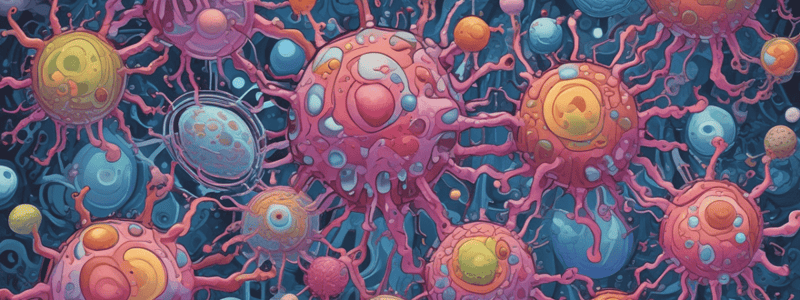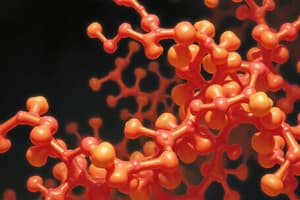Podcast
Questions and Answers
What is the primary function of the peptidoglycan in bacterial cell walls?
What is the primary function of the peptidoglycan in bacterial cell walls?
- To regulate the activity of penicillinases
- To provide structure and support during cell division
- To facilitate the synthesis of β-lactam antibiotics
- To maintain the normal shape and protect against extracellular injury (correct)
What is the effect of β-lactam antibiotics on susceptible bacterial cells?
What is the effect of β-lactam antibiotics on susceptible bacterial cells?
- They inhibit the biosynthesis of cell walls, causing cell death (correct)
- They activate the autolysome, leading to cell lysis
- They enhance the activity of PBPs, leading to cell growth
- They stimulate the production of penicillinases, promoting resistance
How do β-lactam antibiotics interact with PBPs?
How do β-lactam antibiotics interact with PBPs?
- They bind to PBPs, enhancing their activity
- They activate PBPs, promoting cell wall biosynthesis
- They degrade PBPs, leading to cell lysis
- They inhibit PBPs, preventing cell wall biosynthesis (correct)
What is the result of β-lactamase activity on β-lactam antibiotics?
What is the result of β-lactamase activity on β-lactam antibiotics?
What is the role of the autolysome in Gram positive bacteria?
What is the role of the autolysome in Gram positive bacteria?
What is the primary mechanism of resistance to β-lactam antibiotics in bacterial cells?
What is the primary mechanism of resistance to β-lactam antibiotics in bacterial cells?
What is the fate of the old cell wall material during cell division?
What is the fate of the old cell wall material during cell division?
What is the common mode of action of PBPs?
What is the common mode of action of PBPs?
What is the main source of β-lactam antibiotic resistance in bacteria?
What is the main source of β-lactam antibiotic resistance in bacteria?
How do mutated versions of PBP affect β-lactam antibiotics?
How do mutated versions of PBP affect β-lactam antibiotics?
What type of bacteria can have cell wall ultrastructures resembling Streptococcus pneumonia?
What type of bacteria can have cell wall ultrastructures resembling Streptococcus pneumonia?
Which bacteria are mainly targeted by cell wall synthesis inhibiting antibiotics that do not lyse them?
Which bacteria are mainly targeted by cell wall synthesis inhibiting antibiotics that do not lyse them?
Among the β-lactam antibiotics, which class is the most widely used?
Among the β-lactam antibiotics, which class is the most widely used?
What is a fundamental chemical structure of penicillins?
What is a fundamental chemical structure of penicillins?
What has it been more than 90 years since?
What has it been more than 90 years since?
How do β-lactam antibiotics exert their antimicrobial action?
How do β-lactam antibiotics exert their antimicrobial action?
Flashcards are hidden until you start studying
Study Notes
Bactericidal Action of β-Lactam Antibiotics
- The motives behind the bactericidal action of β-lactam antibiotics are not fully understood, but it is hypothesized that the destruction of peptidoglycan synthesis causes the bacteria to kill.
- The lysis in Gram-negative bacteria is hypothesized to be promoted by the digestion of peptidoglycan, leading to the release of muropeptides.
Importance of Peptidoglycan in Bacterial Cells
- Bacterial cells have a rigid cell wall consisting of peptidoglycan, which is essential for survival and provides protection against extracellular injury and maintains their normal shape.
- The absence of a cell wall makes bacterial cells osmotically fragile and prone to taking up excessive water, leading to their death.
Mode of Action of β-Lactam Antibiotics
- β-Lactam antibiotics interrupt the biosynthesis of cell walls in susceptible cells by inhibiting penicillin-binding proteins (PBPs).
- During cell division, most PBPs are engaged in cell wall biosynthesis and spin off the old cell wall material, making them a target for β-lactam antibiotics.
Resistance to β-Lactam Antibiotics
- Bacterial cells can acquire resistance to β-lactam antibiotics by producing broad-spectrum β-lactamases (penicillinases) that can hydrolyze the amide bond in the β-lactam ring.
- The production of β-lactamases is an important source of resistance in Gram-negative and some Gram-positive bacteria.
- Mutated versions of PBPs can reduce the affinity for β-lactam antibiotics, contributing to resistance.
Types of β-Lactam Antibiotics
- β-Lactam antibiotics are the most widely used class of antibiotics, with different agents including penicillins, cephalosporins, monobactams, and carbapenems.
- Penicillins are the most dominant type of β-lactam antibiotic, containing the β-lactam nucleus as its fundamental chemical structure.
Characteristics of Penicillins
- Penicillins are susceptible to β-lactamases, leading to the rapid development of resistance.
- Despite being discovered over 90 years ago, penicillins are still believed to have potential for developing modern and highly potent antibiotics.
Studying That Suits You
Use AI to generate personalized quizzes and flashcards to suit your learning preferences.




